In Round 8 of the 2020-21 Serie A season, the league leaders Milan took another giant step in pursuit of their first Scudetto crown since 2011. On Sunday night, Stefano Pioli’s men cruised past the other Serie A title contenders Napoli, as Zlatan Ibrahimovic scored his fourth brace of the season to secure Milan a 3-1 away win.
Milan remain one of only three teams that are yet to lose this campaign. In contrast, it was Napoli’s third defeat of the season, with Gennaro Gattuso’s men slipping down to the sixth place and finding themselves the same number of points behind the Rossoneri.
This tactical analysis will break down the key playing patterns that had an impact on the final match outcome.
Starting Lineups and Formations

On paper, both managers opted for an identical 4-2-3-1 formation, with a double pivot, two wingers, a center-attacking midfield, and a “number 9.” The only major difference that can be spotted in both teams’ lineups is a profile of their chosen number 9s.
For Napoli, Dries Mertens slotted in a center-forward’s position despite the fact that the 33-year-old can hardly be called a recognized striker. The Belgian was given a “false 9” role, which meant he could drop deeper, and roam around the pitch, exchanging positions with Napoli’s other attacking players. For Milan, their choice upfront resembled a more traditional approach, as Ibrahimovic once again lead the line for the Rossoneri.
Napoli in Attack: Right Flank Preference and Politano’s Influence
Right from the start, Napoli’s main tactical plan was to attack Milan down their left-side where Theo Hernandez, a left-back, was positioned. Napoli’s plan, indeed, seemed logical, with Hernandez bombing forward on every possible occasion, thus leaving loads of space in behind that had to be swiftly covered by a left-sided center-back.
Below we can see one of the examples of the situation outlined above. Matteo Politano, Napoli’s centre-attacking midfielder, breaks through on a counterattack after Hernandez’s unsuccessful cross had left the entire left flank exposed. Milan’s left center-back Alessio Romagnoli initially did a good job by shifting across to cover a vacated space; however, Politano’s pace was too much to handle for Romagnoli, allowing the Italian to break free.
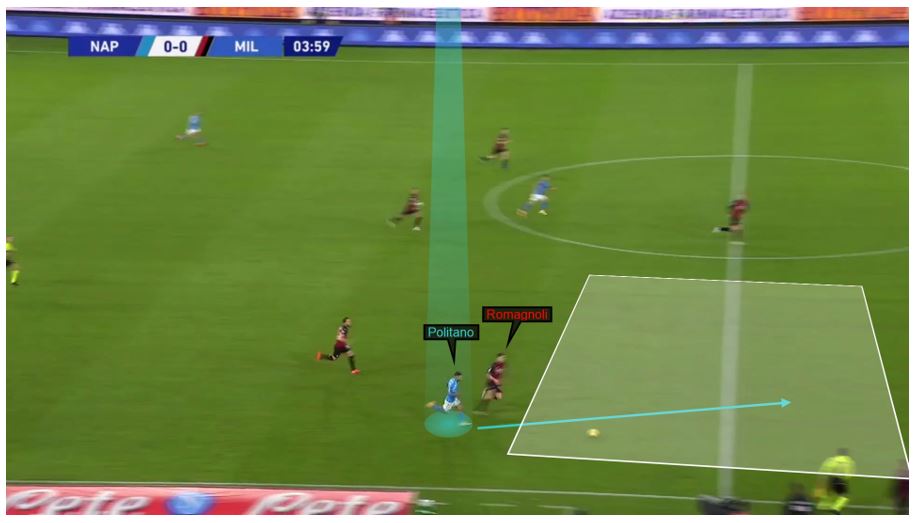
Another similar situation is portrayed in the image below. Hernandez is caught out of position again, with Giovanni Di Lorenzo having plenty of time and space to play a pass down the left side into the channel of Politano or Hirving Lozano. Milan’s high defensive line was ideal for Napoli’s pacey forwards to make runs in behind the two center-backs.
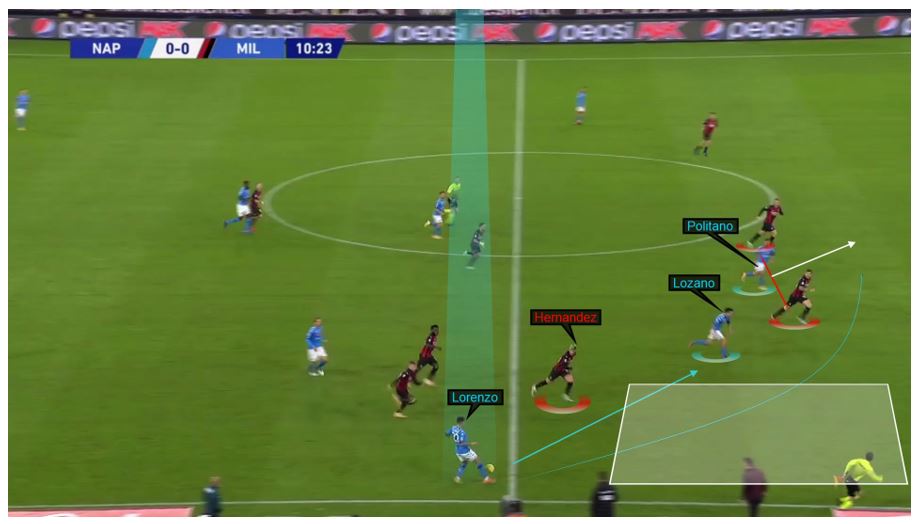
Here is another example of Napoli’s preference to build their play through the left-side of Milan, as Politano receives the ball in between the centre-backs and the midfield. Hernandez is late to react once again, leaving Romagnoli 1 on 1 with Politano. Mertens and Insigne are also both on a front foot, making it a 3 v 3 situation.
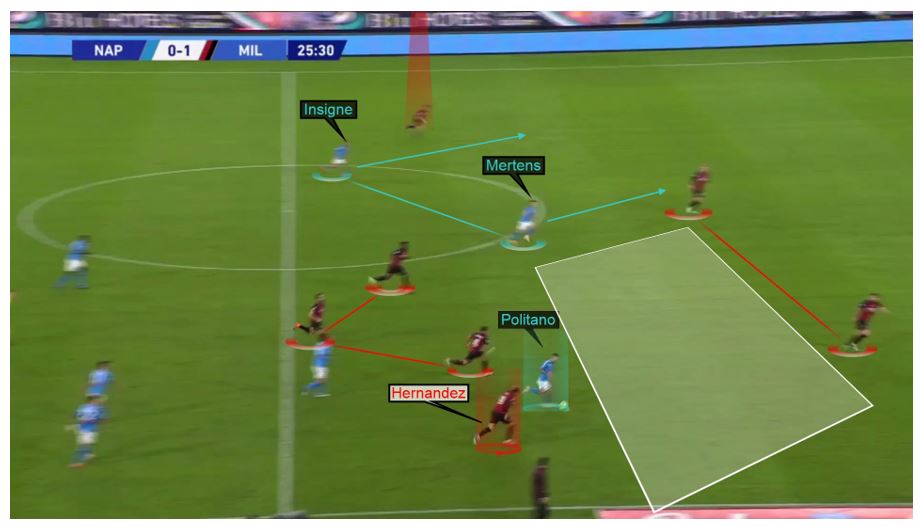
Time and time again in the first half, Napoli tried to exploit Milan’s left flank, with Politano, Di Lorenzo, and Lozano all interchanging positions, and playing through balls into space behind the backline. In this example, Insigne and Mertens are once again left 2 v 2 against the right-sided defenders of Milan. However, Napoli were not as effective in the final third as they were in the build-up phase of getting the ball to the top third of the pitch. In most occasions, Gattuso’s men could not find a final pass that would have reached the arriving Insigne and Mertens.
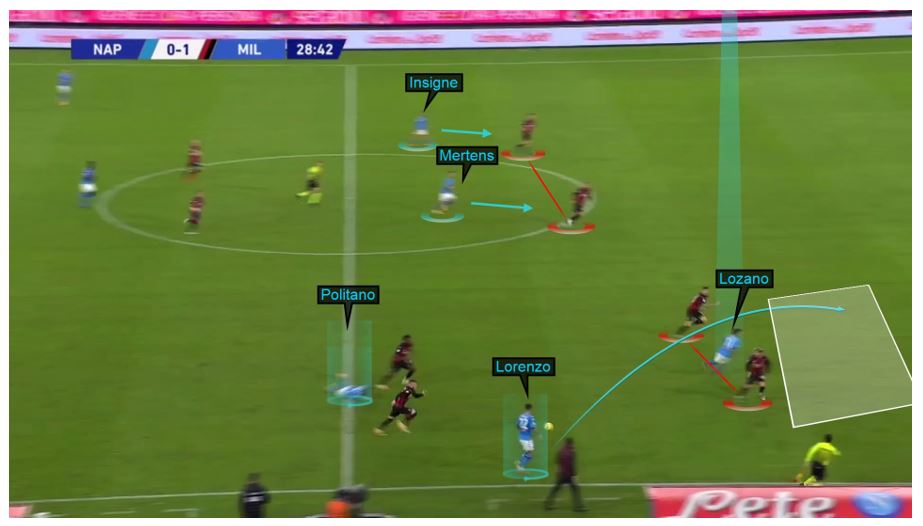
A triangle of Politano, Di Lorenzo, and Lozano was a prevalent scenery throughout the first half. In the graphical annotation displayed below, we can see how easily Napoli were able to break through Milan’s first line of press. Even though Milan’s backline was not exposed as much this time, Politano manages to find himself in acres of space and thus can carry the ball into the advanced areas with two players in support.
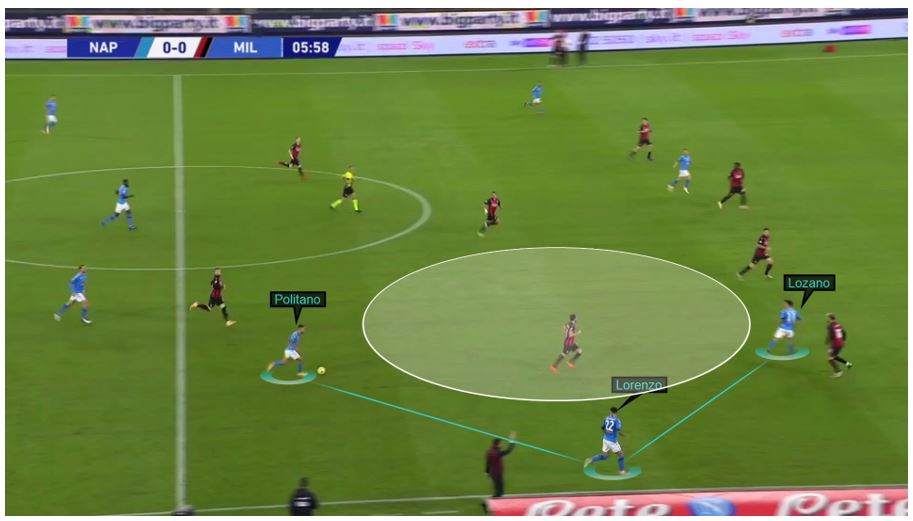
The below graph perfectly supports the analysis we have done so far, as we can see Napoli’s preference to attack down their right (Milan’s left) side from the heat and player positions’ maps.
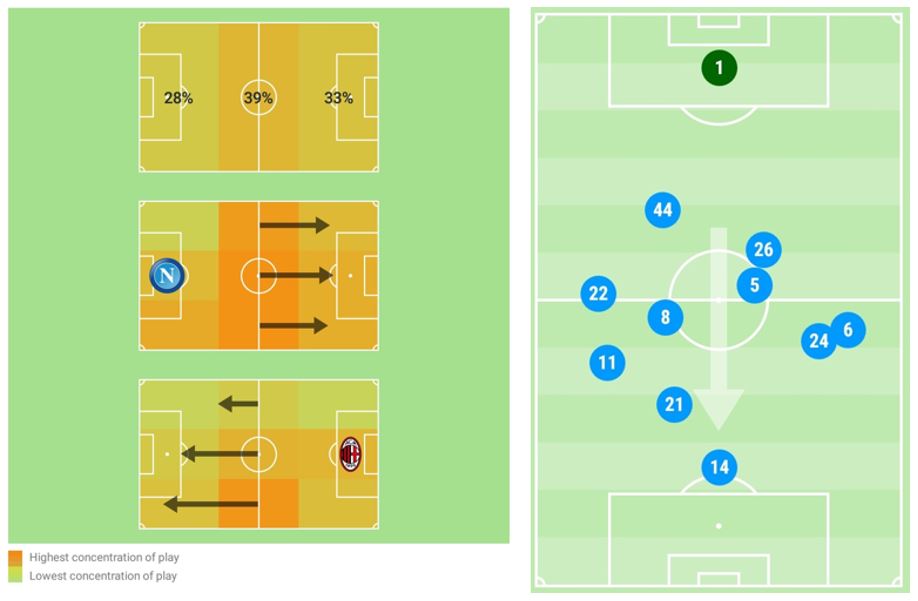
Politano played a key part in connecting Napoli’s midfield and attack, often drifting to the right outer channel, as well as positioning himself centrally in between the lines. The 27-year-old Italian had 53 touches and made 36 passes (2 key passes) with a completion rate of 81%.
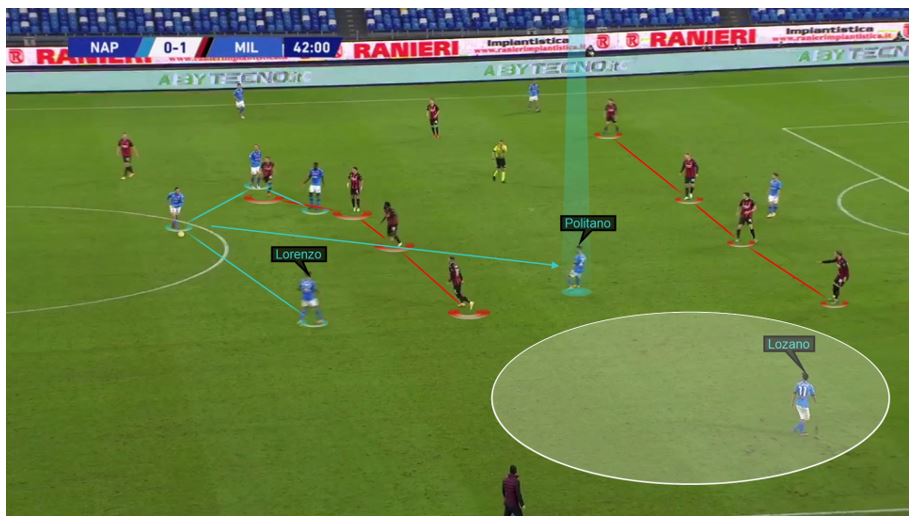
Napoli’s preference to attack down the right flank has been outlined in detail. However, such preference was noticeable in their build-up phase, when Napoli were still moving the ball up the pitch while in the middle third. In the final third of the pitch, the Azzurri were often rotating, using third-man runs, and playing quick one-twos. Consequently, Napoli’s play in the attacking third was flexible, as they rotated a lot and moved the ball from side to side, trying to find the gaps in Milan’s backline.
However, in most cases, the home team was not able to find a killer pass, and their shots from inside and outside the box lacked precision. Despite their dominance in the final third, Napoli created only 2 (62% possession) big chances, compared to Milan’s 4 (38% possession), with 63% of their total shots (19) missing the target.
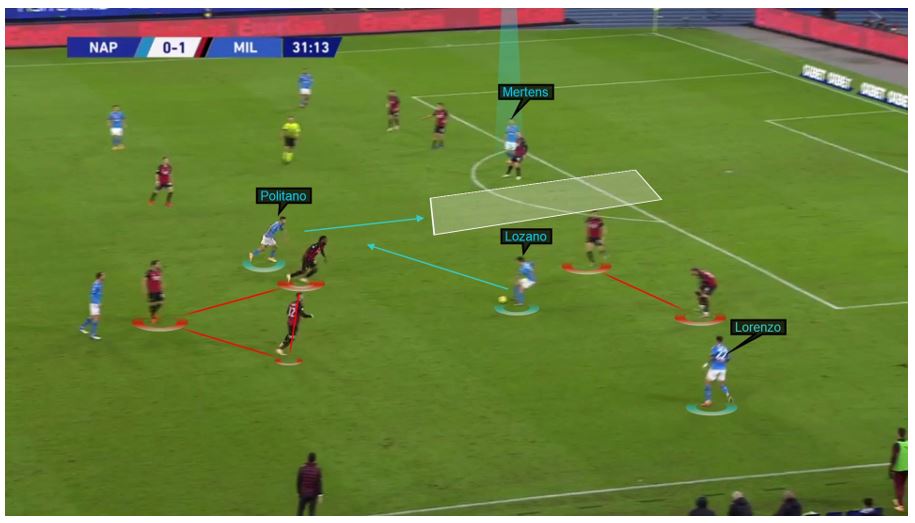
At times, Napoli were also unable to play their way out from the back, as Milan usually deployed a compact high-block to prevent the home team from building up through the middle. In circumstances like this, a “traditional” number 9 is often the answer; however, not in this case. With Mertens upfront, Napoli did not have any height, meaning that playing the long balls would have been pointless, as both Milan’s center-backs would have easily dealt with Napoli’s tiny “number 9”.
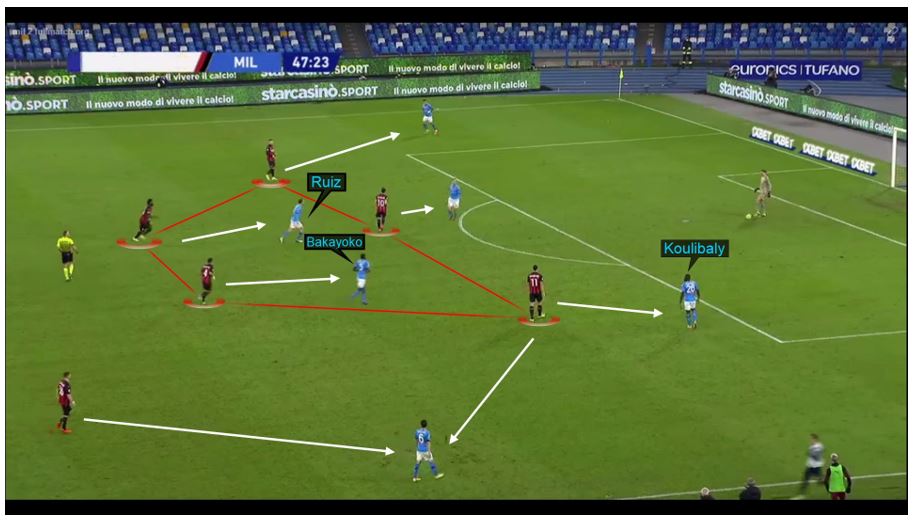
However, at times, Napoli did find a solution, with Koulibaly charging forward to take up a center-forward’s position, thus allowing Napoli’s goalkeeper to play it long.

In the second half, Napoli’s attacking preference shifted from right to left. The two main reasons for that were the substitutions made by Gattuso and the sending-off of Tiemoué Bakayoko. Politano and Lozano, Napoli’s most right-sided attacking players throughout the match, were both substituted, with Piotr Zielinski moving into the centre of midfield to cover Bakayoko’s position. Additionally, Mertens was instructed to continue playing through the center, thus leaving the right side of attack “naked.” Insigne stayed as Napoli’s only wide player that automatically shifted the play to the left.
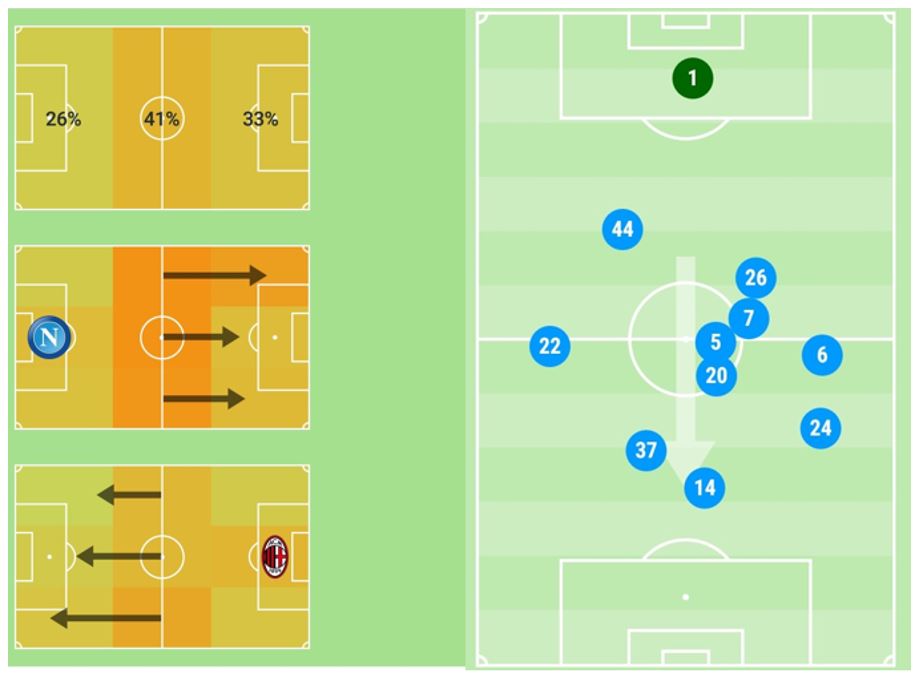
Milan in Attack: Left Flank Preference, Hernandez and Ibra
An interesting trend could be observed in yesterday’s match, as Milan counteracted Napoli’s preference to attack down the right with most of their play occurring on the left flank. What is even more interesting is the fact that one player, Milan’s left-back Hernandez, was its main component.
The Rossoneri’s number 19 is a highly talented, attacking-minded left-back who thrives with the ball at his feet and is extremely dangerous in advanced attacking areas. Yesterday’s game was no exception, as the 23-year-old French left-back made a significant contribution to Milan’s victory over Napoli.
In one of the examples presented below, we can see Hernandez initiating the build-up play down the left side. In this situation, Milan created an overload with four players in close proximity and Ante Rebic making a run in behind for a potential lobbed pass.
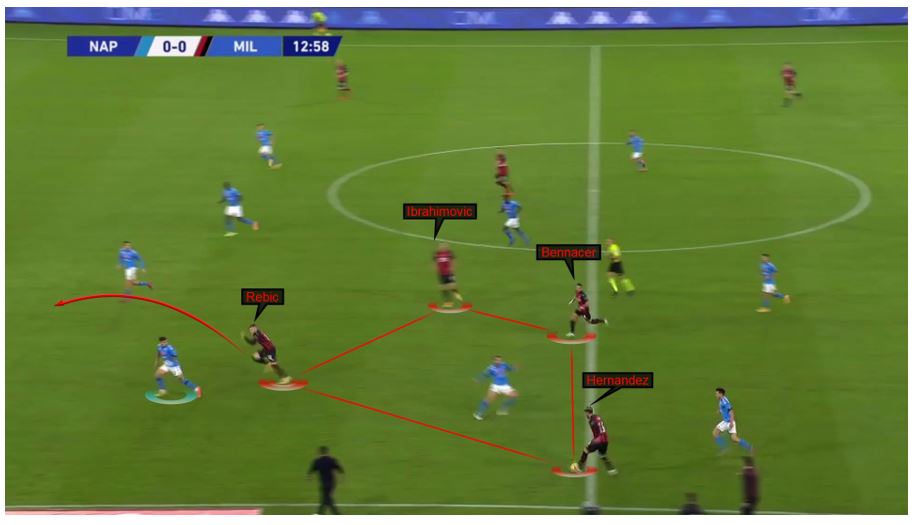
Here, Hernandez and Rebic are both interconnected once again, as the Croatian makes a forward run, thus dragging Fabian Ruiz away from the center and creating space for the Frenchman to drift inside. Milan’s intricate movement down the left side, involving Hernandez, Rebic and one of the central midfielders, caused some real problems to Napoli.
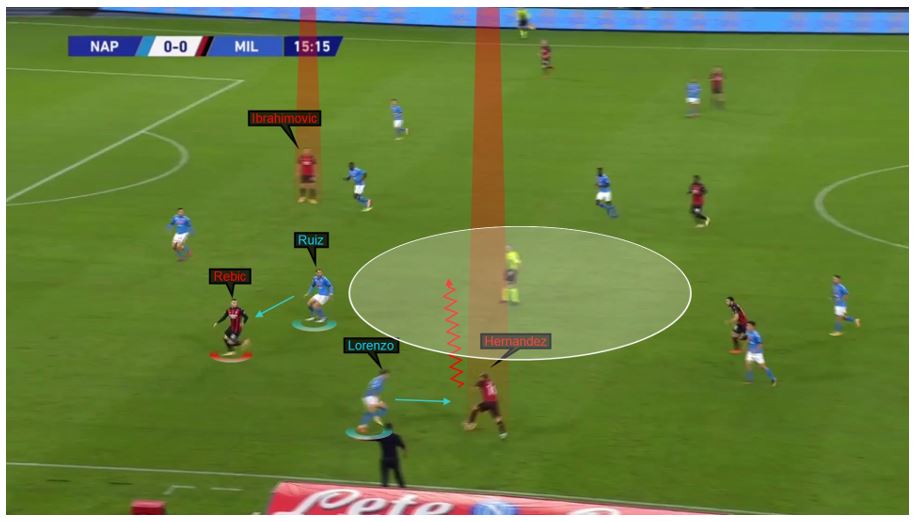
The following situation presents the goal-scoring moment with Hernandez, Rebic, and Calhanoglu involved in the passing triangle down the left flank. Franck Kessié and Ismael Bennacer did a good job inviting Napoli’s midfield higher up the pitch, thus dragging them out of positions which created space for Milan’s trio.
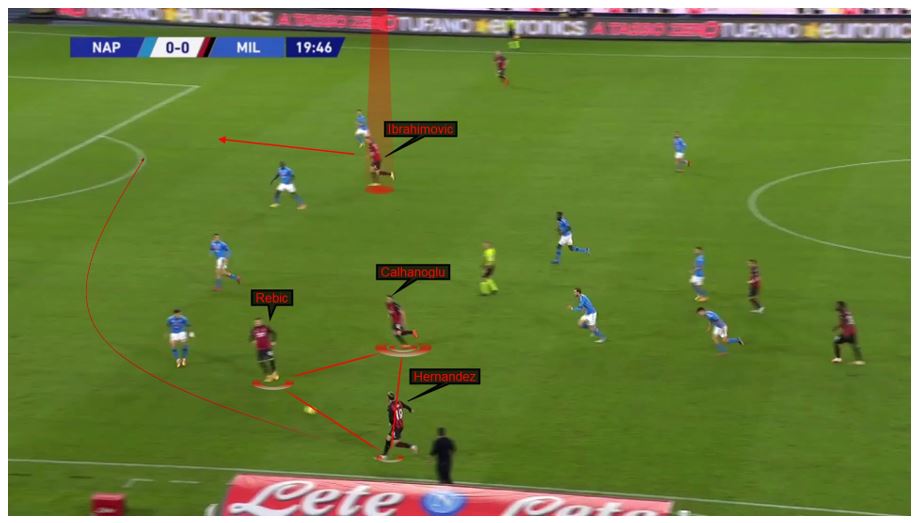
The following heat map and average player positions’ map supports our discussion above. A clear inclination towards the left side is noticeable in both graphics.
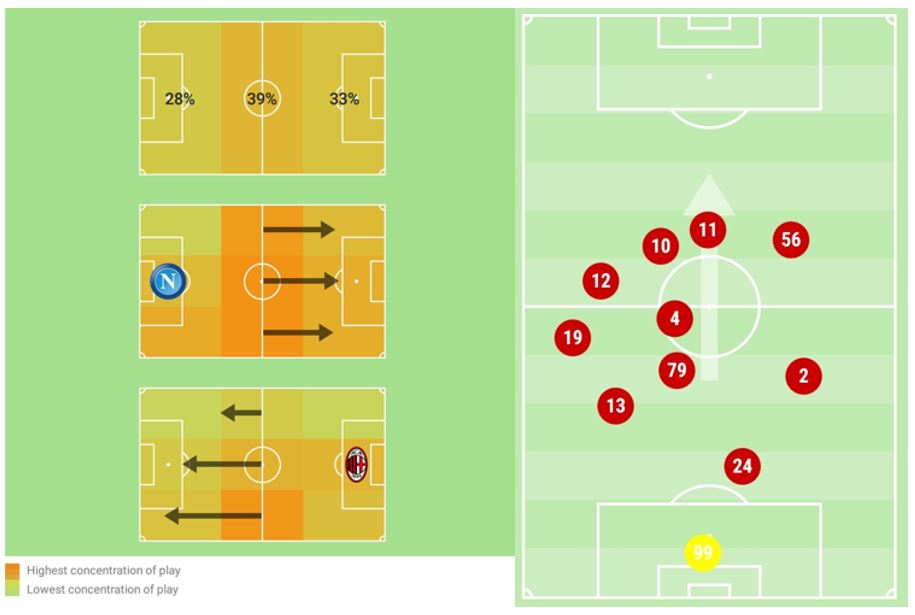
Despite two goals from Ibrahimovic, Hernandez was Milan’s most prevalent asset in attack. The French left-back had 72 touches, made 42 passes, of which 10 were final third passes, with a completion rate of 81% and also completed 3 dribbles.
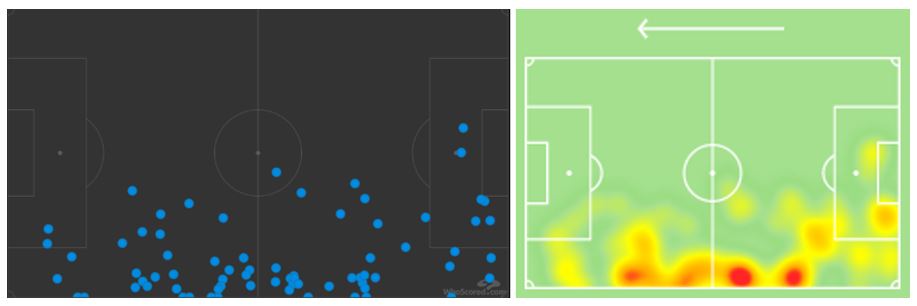
As expected, Napoli were going to have most of the ball; thus, Milan had sharpened their other tool – deadly counterattacks. Both the second and third goals were scored from quick offensive transitions, with Napoli’s midfield completely cut out.
In the example below, we can see Milan’s swift transition play after Napoli had lost the ball deep into the offensive half. Bakayoko is Napoli’s only center-midfield player left in this situation, and with a very high line from the home side, a combination of Calhanoglu, Rebic, and Ibramovic was able to take the advantage of it.
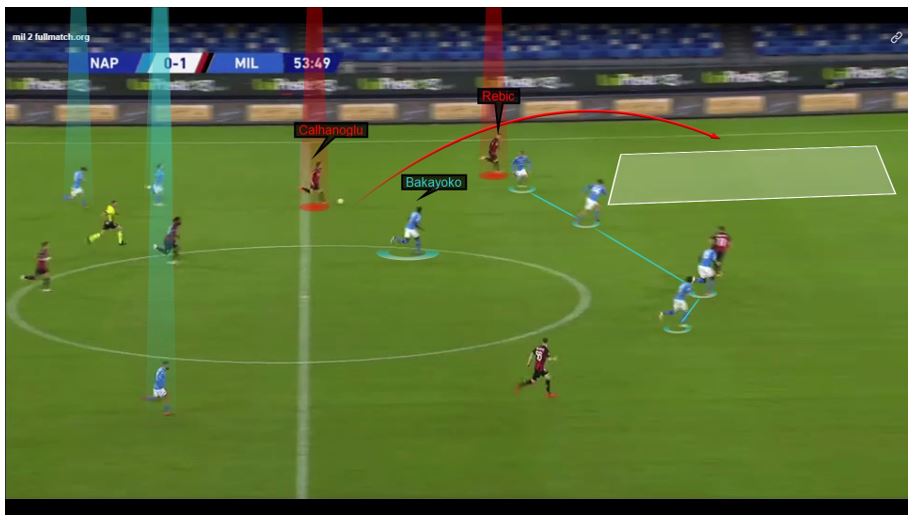
After Mertens pulled one back for Napoli, Milan’s tactics became quite obvious and understandable – to preserve a 2-1 lead. Daniele Bonera told his side to retrieve into a low/mid defensive block with both substitutes Lorenzo Colombo (no. 29) and Jens Petter Hauge (no. 15) given clear instructions to stay high and wide in order to catch Napoli on the break.
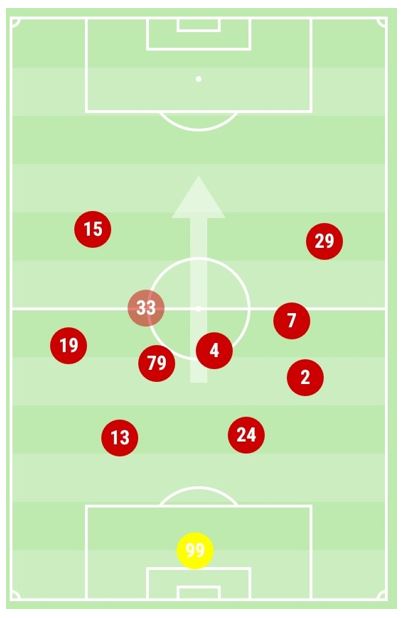
Shot Map of Both Teams
xG (expected goals): Napoli 1.97 – 2.53 Milan
Result: Napoli 1 – 3 Milan

Conclusion
It was another rather typical game of football where one team was more superior on the ball (Napoli) but could not quite find the cutting edge. On the other hand, a more pragmatic approach and perfect game management from Milan seemed to have paid the highest dividends.

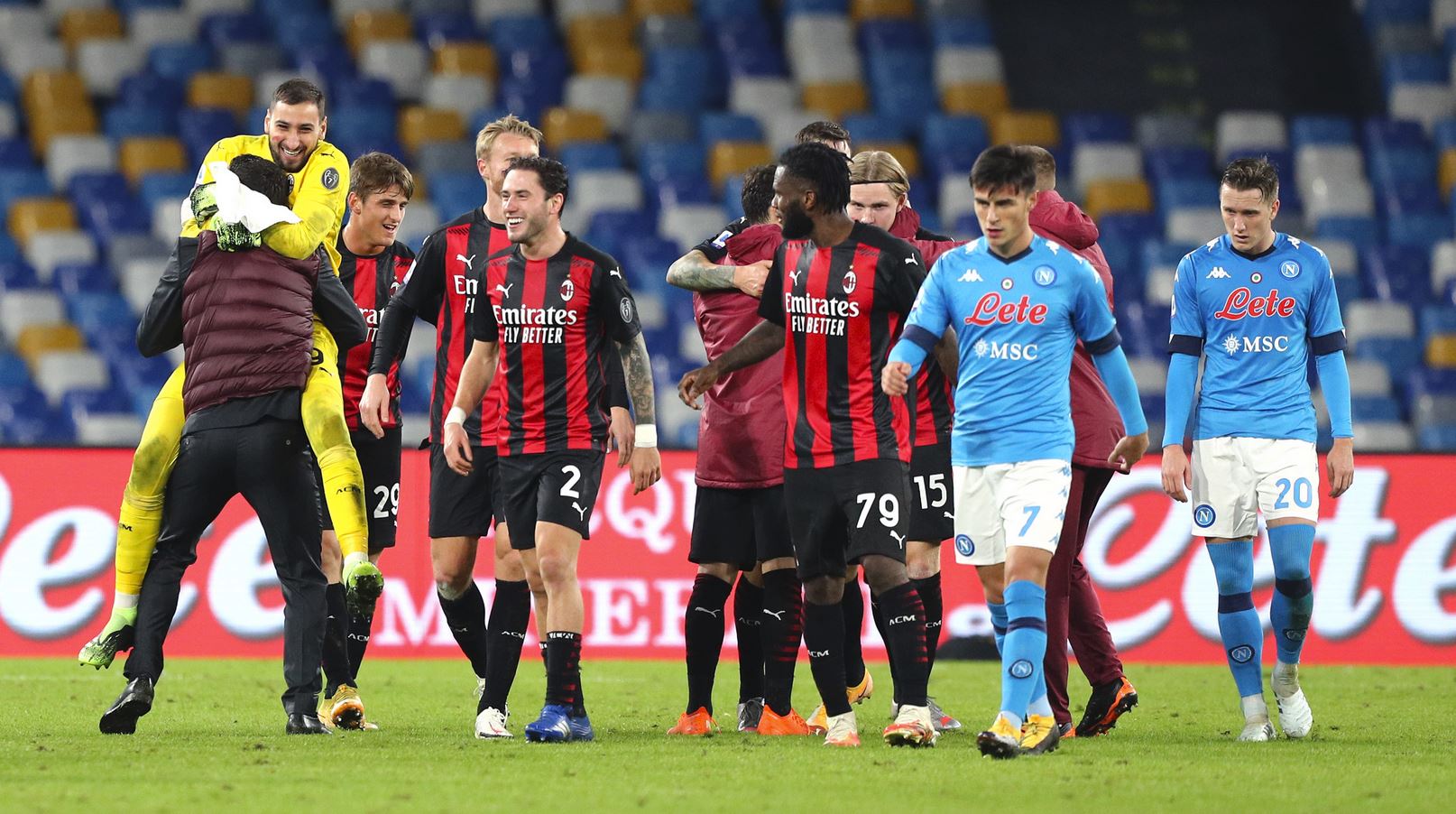
One comment
Comments are closed.